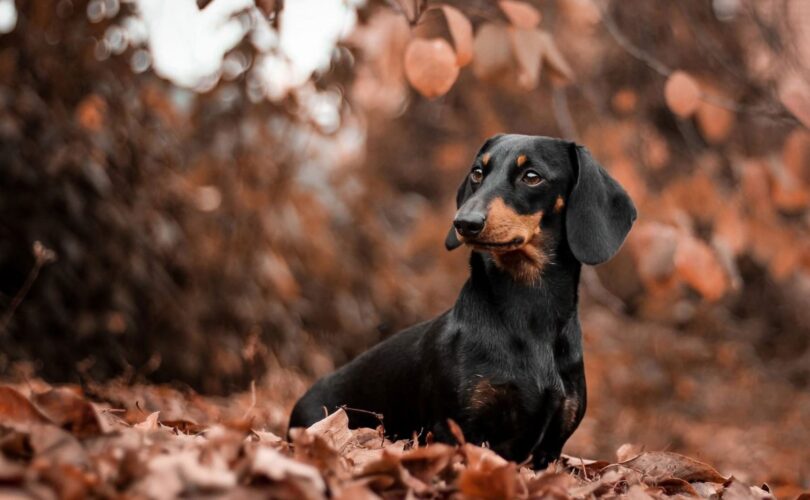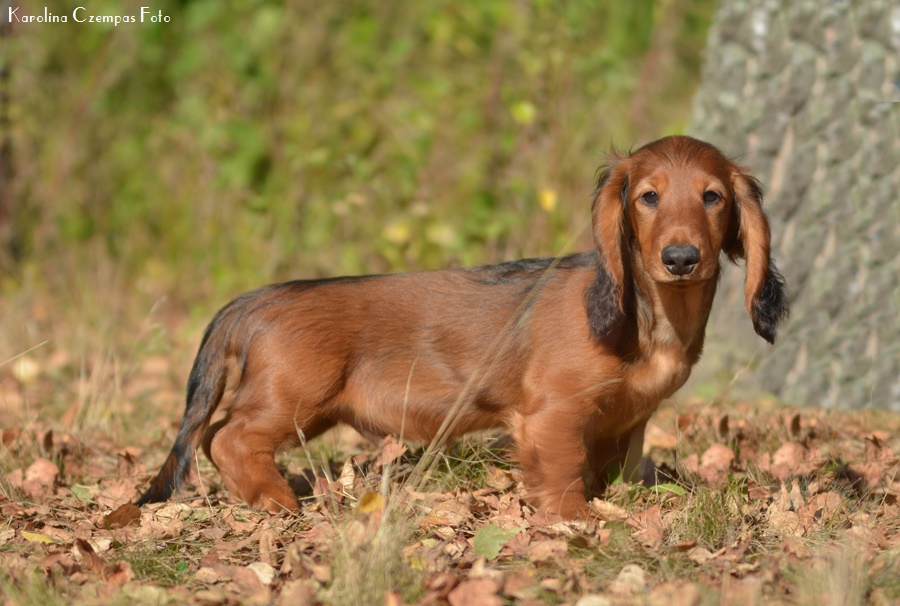Dachshund
TRANSLATION: Mr. Paschoud and his collaborators, updated by Mrs.C.Seidler.
ORIGIN: Germany.
DATE OF PUBLICATION OF THE ORIGINAL VALID STANDARD: 13.03.2001.
UTILIZATION: Hunting dog above and below ground.
CLASSIFICATION F.C.I.: Group 4 Dachshunds.
With working trial.
BRIEF HISTORICAL SUMMARY:
The Dachshund, also called Dackel or Teckel, has been known since the Middle Ages. From the «Bracken», dogs were constantly bred which were specially suitable for hunting below ground. From these short legged dogs, the Dachshund evolved and was recognised as one of the most versatile and useful breeds of hunting dogs. He also has excellent achievements above ground, hunting while giving tongue, searching and tracking wounded game. The oldest Club devoted to the breeding of Dachshunds is the «Deutsche Teckelklub» e.V., founded in 1888.
For decades the Dachshund has been bred in three sizes (Teckel, Miniature Teckel and Rabbit Teckel) and in three different kinds of coat (Smooth-haired, Wire-haired and Long-haired).
GENERAL APPEARANCE:
Low, short legged, elongated but compact build, very muscular with cheeky, challenging head carriage and alert facial expression. His general appearance is typical of his sex. In spite of his legs being short in relation to the long body, he is very mobile and lithe.
IMPORTANT PROPORTIONS:
With the distance above ground level of about one third of the height at withers, the body length should be in harmonious relation to height at withers, about 1 to 1,7 — 1,8.
BEHAVIOUR / TEMPERAMENT:
Friendly by nature, neither nervous nor aggressive, with even temperament. Passionate, persevering and fast hunting dog with an excellent nose.
HEAD:
Elongated as seen from above and in profile. Tapering uniformly towards the nose leather yet not pointed. Superciliary ridges clearly defined. Nasal cartilage and bridge of nose, long and narrow.
CRANIAL REGION:
Skull: Rather flat, gradually merging with the slightly arched nasal bridge.
Stop: Only indicated.
FACIAL REGION:
Nose: Leather well developed.
Muzzle: Long, sufficiently broad and strong. Can be opened wide, split to level of eye.
Lips: Taut fitting, covering the lower jaw well.
Jaws / Teeth: Well developed upper and lower jaw. Scissor bite, even and closing firmly. Ideally, complete set of 42 teeth according to requirements for a dog’s mouth with strong Canines exactly fitting into each other.
Eyes: Medium size, oval, set well apart, with clear energetic yet friendly expression. Not piercing. Colour bright, dark reddish brown to blackish brown in all coat colours. Wall, fish or pearl eyes in dapple dogs are not desired but may be tolerated.
Ears: Set on high, not too far forward. Sufficiently long but not exaggerated. Rounded, not narrow, pointed or folded. Mobile with front edge lying close to cheek.
NECK:
Sufficiently long, muscular. Tight fitting skin on throat. Lightly arched nape of neck, carried freely and high.
BODY:
Upper line: Blending harmoniously from neck to slightly sloping croup.
Withers: Pronounced.
Back: Behind the high withers, topline running from the thoracic vertebrae straight or slightly inclined to the rear. Firm and well muscled.
Loins: Strongly muscled. Sufficiently long.
Croup: Broad and sufficiently long. Slightly sloping.
Chest: Sternum well developed and so prominent that slight depressions appear on either side. The ribcage, seen from the front, is oval. Seen from above and the side, it is roomy, giving plenty of space for the heart and lung development. Ribs carried well back. With correct length and angulation of shoulder blade and upper arm, the front leg covers the lowest point of the sternal line in profile.
Underline and Belly: Slight tuck up.
TAIL:
Not set on too high, carried in continuation of topline. A slight curve in the last third of the tail is permitted.
LIMBS
FOREQUARTERS:
General: Strongly muscled, well angulated. Seen from front, clean front legs, standing straight with good strength of bone; feet pointing straight forward.
Shoulders: Pliant muscles. Long sloping shoulder blade, fitting close to chest.
Upper arm: Equal in length to shoulder blade, set almost at right angle to same. Strong boned and well muscled, close fitting to ribs but free in movement.
Elbows: Turning neither in nor out.
Forearm: Short, yet so long that the dog’s distance from the ground is about one third of its height at withers. As straight as possible.
Pastern joints: Slightly closer together than the shoulder joints.
Pastern: Seen from the side, should be neither steep nor noticeably inclined forward.
Front feet: Toes close together, well arched with strong, resistant, well cushioned pads and short strong nails. The fifth toe has no function but must not be removed.
HINDQUARTERS:
General: Strongly muscled, in correct proportion to forequarters. Strong angulation of stifles and hock joints. Hindlegs parallel standing neither close nor wide apart.
Upper thigh: Should be of good length and well muscled.
Stifle (joint): Broad and strong with pronounced angulation.
Lower thigh: Short, almost at right angle to upper thigh. Well muscled.
Hock joint: Clean with strong tendons.
Hock: Relatively long, mobile towards lower thigh. Lightly curved forward.
Hind feet: Four close knit toes, well arched. Standing firmly on strong pads.
GAIT / MOVEMENT:
Movement should be ground covering, flowing and energetic, with far reaching front strides without much lift, and strong rear drive movement should produce slightly springy transmission to backline. Tail should be carried in harmonious continuation of backline, slightly sloping. Front and hindlegs have parallel movement.
SKIN:
Tight fitting.
COAT
SMOOTH-HAIRED
HAIR: Short, dense, shiny, smooth fitting, tight and harsh. Not showing any bald patches anywhere.
Tail: Fine, fully but not too profusely coated. Somewhat longer guard hair on underside is not a fault.
COLOUR:
a) Whole-coloured: Red, reddish yellow, yellow, all with or without interspersed black hairs. A clear colour is preferable and red is of greater value than reddish yellow or yellow. Even dogs with strongly interspersed black hairs are classed as whole-colour, not as other colours. White is not desired but single small spots do not disqualify. Nose and nails black. reddish-brown is also permissible but not desirable.
b) Two-coloured: Deep black or brown, each with tan or yellow markings («Brand») over eyes, on sides of muzzle and of lower lip, on inner edge of leathers, on forechest, on inside and rear side of legs, also on the feet, round the vent and from there reaching to about one third or one-half of the underside of the tail. Nose and nails black in black dogs, brown in brown dogs. White is not desired but single small spots do not disqualify. Tan or yellow marking («Brand») too wide spread is undesirable.
c) Dappled (Tiger-brindle, brindle): The basic colour is always the dark colour (black, red or grey). Desired are irregular grey or beige patches (large patches not desired). Neither the dark nor the light colour should be predominant. The colour of a brindle Dachshund is red or yellow with darker brindle. Nose and toenails are the same as with the whole- and two-coloured.
WIRE-HAIRED
HAIR: With exception of muzzle, eyebrows and leathers, perfectly even close fitting, dense wiry topcoat with undercoat. The muzzle has a clearly defined beard. Eyebrows are bushy. On the leathers, the coat is shorter than on the body, almost smooth.
TAIL: Well and evenly covered with close fitting coat.
COLOUR: Dominantly light to dark wild boar colour as well as colour of dry leaves. Otherwise same colours as described under Smooth-haired a-c.
LONG-HAIRED
HAIR: The sleek shiny coat, with undercoat and close fitting to body, is longer at the throat and on underside of body. On leathers the hair must extend beyond the lower edge of ears (feathering). Distinct feathers on rear side of legs. Achieves its greatest length on underside of tail and there forms a veritable flag.
COLOUR: As described in Smooth-haired a-c.
SIZE AND WEIGHT / IMPORTANT MEASUREMENTS:
Dachshund: Circumference of chest 35 cm. Upper weight limit about 9 kg.
Miniature Dachshund: Circumference of chest from 30 to 35 cm measured when at least 15 months old.
Rabbit Dachshund: Chest circumference up to 30 cm measured when at least 15 months.
Weight: Standard Dachshund up to about 9 kg.
FAULTS:
Any departure from the foregoing points should be considered a fault and the seriousness with which the fault should be regarded should be in exact proportion to its degree and its effect upon the health and welfare of the dog.
M3 (Molar 3) are not to be considered when judging. Lack of 2PM1 (Premolar 1) is not to be penalised. The absence of PM2 should be regarded as a fault, if other than M3, no other teeth are missing, also a departure from the correctly closing scissor bite.
SERIOUS FAULTS:
- Weak, long-legged or body trailing on ground.
- The absence of teeth other than those described among «faults» or «eliminating faults».
- Wall eye in any colour other than dapple.
- Pointed, very folded ear leathers.
- Body suspended between shoulders.
- Hollow back, roach back.
- Weak loins.
- Marked running up at rear (croup higher than withers).
- Chest too weak.
- Flanks with whippety-like tuck up.
- Badly angulated fore- and hindquarters.
- Narrow hindquarters, lacking muscle.
- Cow hocks or bow legs.
- Feet turning markedly inwards or outwards.
- Splayed toes.
- Heavy, clumsy, waddling movement.
FAULTY COAT:
SMOOTH -HAIRED DACHSHUND:
- Coat too fine or thin. Bald patches on leathers (leather ear), other bald areas.
- Coat much too coarse and much too profuse.
- Brush like tail.
- Tail partially or wholly hairless.
- Black colour without any marking («Brand»).
WIRE-HAIRED DACHSHUND:
- Soft coat, whether long or short.
- Long coat, standing away from body in all directions.
- Curly or wavy coat.
- Soft coat on head.
- Flag on tail.
- Lack of beard.
- Lack of undercoat.
- Short coat.
LONG-HAIRED DACHSHUND:
- Coat of equal length all over body.
- Wavy or shaggy coat.
- Lack of flag (tail).
- Lack of overhanging feathering on ears.
- Short coat.
- Pronounced parting in coat on back.
- Hair too long between toes.
ELIMINATING FAULTS:
- Very anxious or aggressive nature.
- Overshot or undershot mouth, wry mouth.
- Faulty position of the lower canines.
- Absence of one or more canines; absence of one or more incisors.
- Lack of other premolars or molars. Exceptions: The two PM1, one PM2 without consideration of M3, as mentioned under Faults.
- Chest: Sternum cut off.
- Any fault of tail.
- Very loose shoulders.
- Knuckling over in pasterns.
- Black colour without markings (Brand); white colour with or without markings (Brand).
- Colours other than those listed under «Colour».
Any dog clearly showing physical or behavioural abnormalities shall be disqualified.
N.B.: Male animals should have two apparently normal testicles fully descended into the scrotum.







